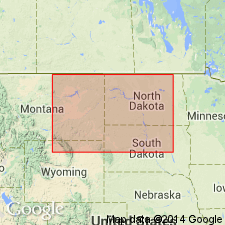
- Usage in publication:
-
- Saude formation
- Modifications:
-
- Named
- Dominant lithology:
-
- Sandstone
- Redbeds
- Mudstone
- Anhydrite
- AAPG geologic province:
-
- Williston basin
Summary:
Named as a formation in Williston basin, ND, SD, and MT. Type section not designated. [Presumably name is from Phillips Saude No. 1 well, NW1/4 SE1/4 sec 19, T156N, R72W, Pierce Co, ND, which is shown on a cross section illustrating correlation of the formation.] Occupies central part of Williston basin mostly in western ND but extending into eastern MT and northwestern SD. Formerly an undifferentiated part of Spearfish formation. Is predominantly reddish-orange siltstone and very fine grained sandstone with medium- to coarse-grained sandstone interbeds and reddish-brown and greenish-gray mudstone streaks. Anhydrite is present usually as inclusions or blebs in the finer grained matrix, but some distant interbeds have been noted. Well-rounded, nearly spherical, frosted quartz grains as much as 1 mm in diameter occur scattered through the silty beds. Maximum thickness [from isopach map] somewhat more than 300 ft. Is an onlapping unit, losing section from base as its zero edge is approached. Overlain conformably by Dunham salt (new), or where Dunham is absent, overlain unconformably by Piper formation; overlies conformably Pine salt (new), or where Pine salt is absent, overlies unconformably rocks ranging in age from Permian? to Devonian. Assigned a Jurassic age based on similarity of its depositional pattern to that of overlying Jurassic Piper formation. Correlated with Watrous formation and/or Amaranth red beds of Canada.
Source: GNU records (USGS DDS-6; Denver GNULEX).
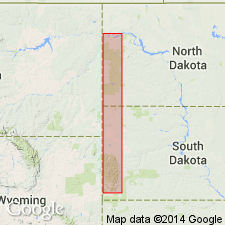
- Usage in publication:
-
- Saude formation
- Modifications:
-
- Age modified
- Overview
- AAPG geologic province:
-
- Chadron arch
- Williston basin
Summary:
Subdivided Spearfish formation in Williston basin into (descending) units A-D. Unit B equivalent to Saude formation of Zieglar (1955). Unit B identified as a sequence 80 ft thick of orange-red siltstone grading to fine sandstone that makes up the upper part of Spearfish formation in a section at Buffalo Gap, Custer Co, SD on the east side of the Black Hills. The siltstone-sandstone sequence is recognizable in Chugwater formation in the Bighorn basin. Is assigned a Late Triassic age based on correlation with better dated formations in central WY.
Source: GNU records (USGS DDS-6; Denver GNULEX).

- Usage in publication:
-
- Saude formation*
- Modifications:
-
- Overview
- Age modified
- AAPG geologic province:
-
- Williston basin
Summary:
A siltstone and claystone sequence called Saude formation by Zieglar (1955) in the Williston basin is assigned to Spearfish formation and correlated with a siltstone-mudstone unit comprising the upper part of Spearfish in the Black Hills, SD and WY. Mottled mudstone in the lower part of the equivalent sequence in the Black Hills is correlated with Dinwoody formation. Equivalents of Saude formation of Zieglar (1955) in Williston basin, and the upper part of Spearfish formation in the Black Hills, are assigned to the Lower Triassic based on correlations with Triassic rocks elsewhere in WY.
Source: GNU records (USGS DDS-6; Denver GNULEX).
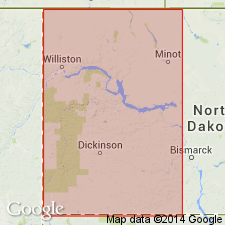
- Usage in publication:
-
- Saude Member
- Modifications:
-
- Revised
- Overview
- Age modified
- AAPG geologic province:
-
- Williston basin
Summary:
Revised lower contact and assigned as a member of Spearfish Formation. Includes at base a persistent anhydrite and salt unit (called the G marker bed) and an underlying siltstone unit, both of which were made part of underlying Pine Salt by Zieglar (1955). Conformably overlies Pine Salt Member (revised); unconformably underlies Dunham Beds of Piper Formation [formerly Dunham Salt of Zieglar (1955)]. Predominantly Triassic in age except that the upper part may include the Jurassic-Triassic boundary in northern ND. Age assignment based on correlations with the better dated Goose Egg Formation in central WY, and with the lower part of Watrous Formation in Saskatchewan, Canada. Includes isopach map and correlation diagrams.
Source: GNU records (USGS DDS-6; Denver GNULEX).
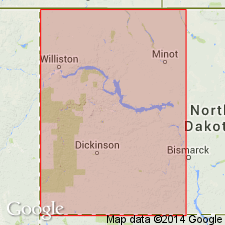
- Usage in publication:
-
- Saude Member
- Modifications:
-
- Principal reference
- AAPG geologic province:
-
- Williston basin
Summary:
Expanded version of Dow (1964). Includes a reference section [designated type section by the author] described as the interval between 6,290 and 6,610 in the Amerada Petroleum Corporation Pederson Cater No. 1 well, NE1/4 SW1/4 sec 21, T158N, R95W, Williams Co, ND. Includes (descending): shale, moderate-reddish-brown to pale-reddish-brown, slightly calcareous, silty, some white anhydrite, 60 ft; siltstone, moderate-reddish-orange, slightly calcareous, very fine to fine rounded quartz grains, a little white anhydrite, 180 ft; siltstone, as above; traces of colorless anhydrite and moderate-reddish-orange sandstone, 80 ft. Conformably overlies Pine Salt [as revised (Dow, 1964)]. Overlain by Poe Member of Piper Formation; contact is probably conformable in much of northwestern ND and Canada, but is unconformable to the west and south. Is mostly Triassic in age except in northern ND where the Jurassic-Triassic boundary may lie within the upper part of the formation.
Source: GNU records (USGS DDS-6; Denver GNULEX).
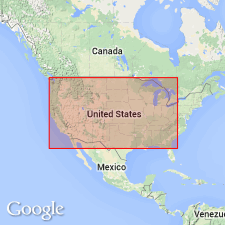
- Usage in publication:
-
- Saude Formation*
- Modifications:
-
- Age modified
- Overview
- AAPG geologic province:
-
- Williston basin
Summary:
Boundaries defined according to Zieglar (1955) in the vicinity of Pine oil field, Wibaux Co, MT. Forms a wedge through onlap against strata of Chugwater or Spearfish Formation of Early Triassic age in the subsurface of Powder River and Williston basins north of the Black Hills. Is believed to have formed chiefly through erosion of Spearfish. Consequently the red beds of this formation are very similar to those of Spearfish, and the two units are difficult to separate where they are in contact. Is unfossiliferous but seems to be related to the transgressive cycle of sedimentation which began in earlier Jurassic or Late Triassic time and produced overlying Piper Formation of definite Middle Jurassic age. Conformable with overlying Gypsum Spring Formation; unconformable with underlying Pine Salt of Zieglar (1955), or where erosion at base of Saude has cut less deeply; is unconformable on red beds that conformably overlie Pine Salt of Zieglar (1955). Assigned a Jurassic age. Cross section shows unit pinching out southward in northeasternmost WY.
Source: GNU records (USGS DDS-6; Denver GNULEX).
For more information, please contact Nancy Stamm, Geologic Names Committee Secretary.
Asterisk (*) indicates published by U.S. Geological Survey authors.
"No current usage" (†) implies that a name has been abandoned or has fallen into disuse. Former usage and, if known, replacement name given in parentheses ( ).
Slash (/) indicates name conflicts with nomenclatural guidelines (CSN, 1933; ACSN, 1961, 1970; NACSN, 1983, 2005, 2021). May be explained within brackets ([ ]).

